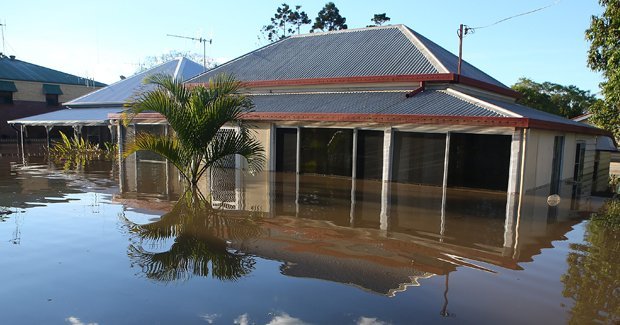Aussies refuse to flood-proof homes: report

THE IMPACT OF FLOODS is better understood since the 2010-11 floods across eastern Australia, but still people are not adapting their homes against the next event, a recent report claims.
The National Climate Change Adaptation Research Facility (NCCARF) recently released a report assessing responses to the 2010-11 floods, which caused $2.5 billion in insured losses, inundated over 30,000 properties and saw 35 lives lost.
Predicting flood damage
Dr Matthew Mason, a research engineer at Macquarie University, Sydney, has developed a new computer model recognised by NCCARF, that predicts financial losses and home displacement as a result of floods.
Matthew says the program can be used “in any scenario” to quickly predict and assess potential flood damage.
See images of the 2010-11 floods
The leader of the report by NCCARF, Dr Deanne Bird, says that although the impact of floods can be predicted more effectively, this information is not always understood by the people most at risk.
Many of the people interviewed for the report, says Deanne, “were aware of the future vulnerability to floods but many just weren’t taking changes to reduce their risk.”
One reason that could explain this is the large cost of flood-proofing homes compared to insuring them.
Matthew agrees, pointing out that building guidelines in flood-prone areas are mostly voluntary, and are not always adhered to. “If you’re not forced to do it, most people tend not to,” he says.
Residents don’t receive adequate flood warning
Deanne says the communication of information was inconsistent across flood-affected regions during 2010-11.
Residents of Emerald, Queensland, for example, were well-prepared thanks to extra flood monitoring systems installed following the 2008 floods. However, in other areas, such as Donald, Victoria, information was harder to come by.
Greg Nunn, chairman of the Donald Community Flood Recovery Committee, says there were hardly any police, fire brigade or local council representatives when the flood reached the town of Donald, 280km north-west of Melbourne.
“It was on the news up in Queensland and New South Wales that Donald was being evacuated and we knew nothing of it,” says Greg.
See images of the 2010-11 floods
How to flood-proof a house
Matthew Mawson had these tips for flood-proofing a house:
Dry flood-proofing: keep water out of the house using floodgates – removable barriers that create a seal around the base of doors and vents in brickwork
Wet flood-proofing: in severe floods, walls can be damaged if water builds up against them; wet flood-proofing involves letting water in and out as easily as possible using tiled floors and water-resistant plaster boards
Electrical appliances: Have electrical appliances that can be easily lifted to higher locations, or keep them in high locations in the first place, e.g. a front-loading washing machine on a shelf instead of a top-loader on the ground
RELATED STORIES

